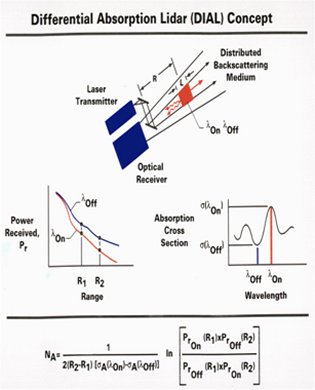|
|
|
DIAL
 A simplified version of the Differential Absorption Lidar (DIAL) concept is shown in the figure below.
With the DIAL technique, the gas concentration profile is determined by analyzing the lidar backscatter signals
for laser wavelengths tuned "on" ( on) and "off" ( off) an absorption line of the gas of interest.
The absorption regions are in the UV near 300 nm for ozone and in
the IR near 727 or 815 nm for water vapor. In this technique,
the wavelength separation between the on and off wavelengths is
minimized to avoid differences in the atmospheric backscatter at the two wavelengths.
The value of the average gas concentration NA (cm-3) in the range interval from R1 to R2
can be determined from the ratio of the lidar signals at the on and off wavelengths, where sA(on)-sA (off)
is the difference between the absorption cross-sections at the on and off wavelengths, and Pr,on(Ri) and Pr,off(Ri)
are the signal powers received from range Ri at the on and off wavelengths, respectively.
A simplified version of the Differential Absorption Lidar (DIAL) concept is shown in the figure below.
With the DIAL technique, the gas concentration profile is determined by analyzing the lidar backscatter signals
for laser wavelengths tuned "on" ( on) and "off" ( off) an absorption line of the gas of interest.
The absorption regions are in the UV near 300 nm for ozone and in
the IR near 727 or 815 nm for water vapor. In this technique,
the wavelength separation between the on and off wavelengths is
minimized to avoid differences in the atmospheric backscatter at the two wavelengths.
The value of the average gas concentration NA (cm-3) in the range interval from R1 to R2
can be determined from the ratio of the lidar signals at the on and off wavelengths, where sA(on)-sA (off)
is the difference between the absorption cross-sections at the on and off wavelengths, and Pr,on(Ri) and Pr,off(Ri)
are the signal powers received from range Ri at the on and off wavelengths, respectively.
The location of this range cell can be moved along the length of the lidar returns,
providing the profile of the gas along the line-of-sight of the DIAL system.
The gas mixing ratio profile can then be obtained by dividing the gas concentration
profile by the atmospheric number density profile along the same direction.
The aerosol and cloud distributions can be obtained at the same time from the lidar return at the off wavelength.
To remotely measure ozone concentrations in the troposphere, the DIAL technique requires
"on" to be in the Hartley-Huggins band near 289 nm, and due to the nature of the ozone absorption,
the nearest appropriate wavelength that can be used as the "off" is at the edge of the absorption
band near 300 nm. Since the ozone mixing ratio in the troposphere varies over a wide range from 10
to 150 ppbv, "on" is often adjusted to optimize the DIAL measurement for each field experiment.
For stratospheric DIAL measurements of ozone, "on" near 301 nm and "off" near 311 nm are used.
|





